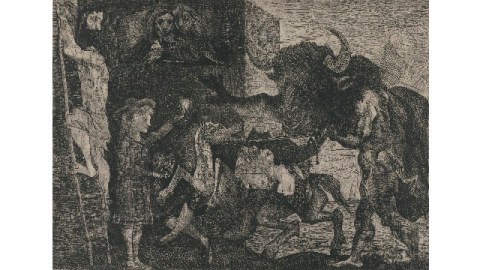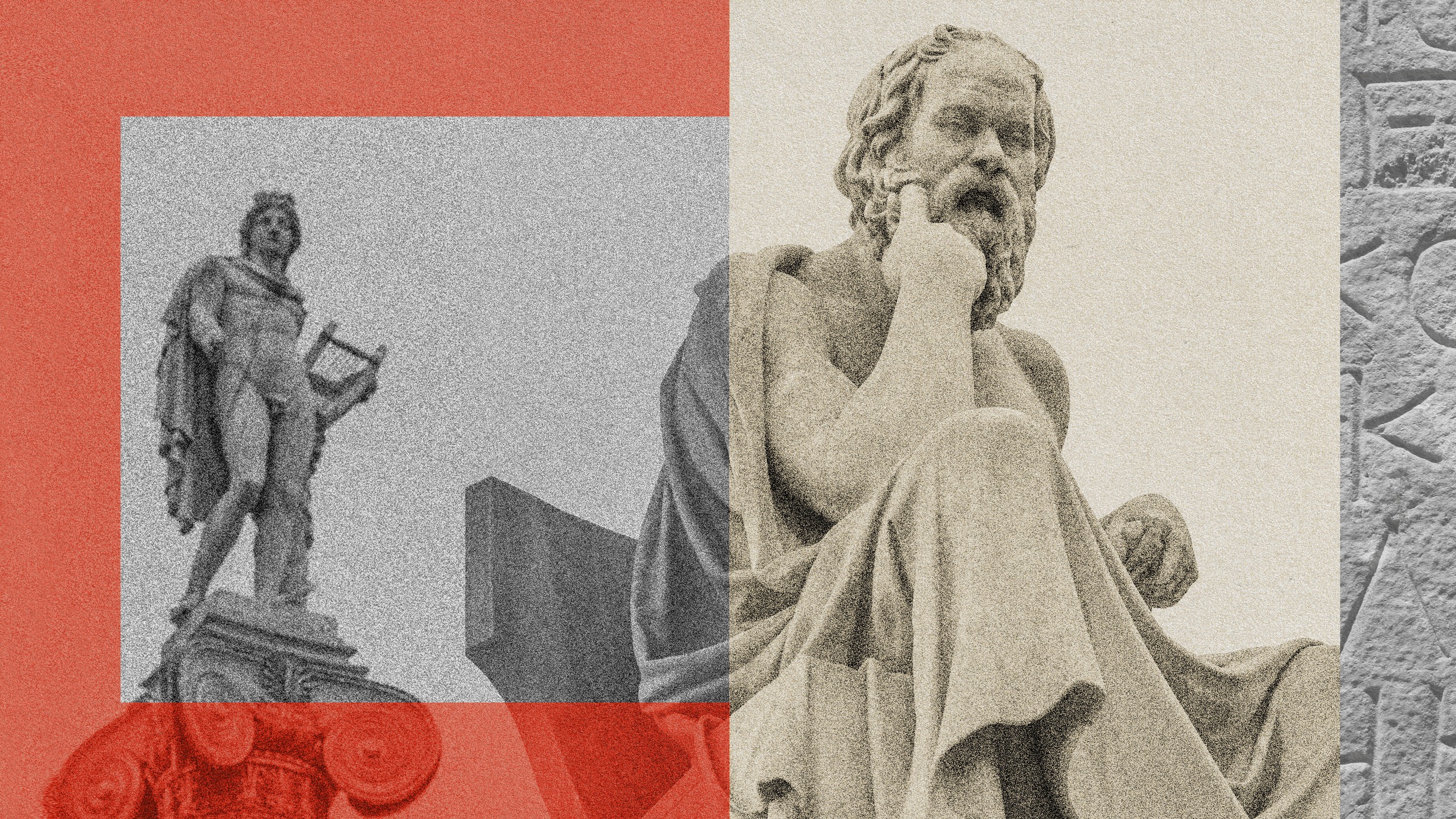How Picasso Mythologized Love and War

After a trip to Italy in February 1917, Pablo Ruiz y Picasso decided to go back to basics in his art. Like so many other artists and pretty much the entire world, Picasso wanted to leave behind the Cubist style matching the modernist discord of World War I for a neoclassicm that emulated the harmonious artistry of the Ancient Romans and Greeks. Despite this turn towards the past, Picasso’s private and public present continually intruded, resulting in a mythologizing of his loves and wars. In the Philadelphia Museum of Art’s new exhibition Picasso Prints: Myths, Minotaurs, and Muses, we see Picasso refashion ancient myths into personal alter egos from the 1920s through the 1950s as a way of dealing with events in his convoluted love life as well as the convoluted politics of his native Spain, specifically in the masterpiece of Guernica. In choosing the Minotaur—a figure simultaneously of great violence and great sexual energy—as his avatar, Picasso reinvented the game of classical symbolism and forged a modern mode for mythology.
With the exception of a single painting and one sculpture, Picasso Prints: Myths, Minotaurs, and Muses lives up to its title, featuring works on paper almost all taken from the Philadelphia Museum of Art’s holdings, including their own collection of the Vollard Suite, the eventually 100-image series Ambroise Vollard, Picasso’s dealer in Paris, commissioned from Picasso in 1930 but which was not completed until 1937. The earliest image in the exhibition dates back to 1921, when Picasso created The Spring, a drypoint and engraving of three Muses collecting water from the Hippocrene (Greek for “Horse’s Fountain”), the spring created by the winged horse Pegasus stomping his hoof. According to legend, a drink of that water would inspire the drinker to poetic greatness. Picasso certainly hoped to tap into the past for inspiration in choosing such subjects, but was always on the lookout for modern connections. When he spied 17-year-old Marie-Thérèse Walter in front of a Parisian department store in 1927, the 45-year-old artist found his fountain of youth in what he called her classical, Grecian features, which he captured in profile in a lithograph a year later and continued to depict obsessively throughout their eight years together.
Just as Picasso saw his young mistress as the Louvre’s Greek art come alive, he imagined himself as a modern Minotaur. Taking the metaphorical bull by the horns, Picasso showed himself again and again as the mythic figure with the body of a man the head of a bull. Images in the popular media of the recently excavated Bull-Leaping Fresco (from 1400 BCE) at the palace at Knossos, Crete, Greece fired Picasso’s imagination further. Early images from the Vollard Suite show Picasso as Minotaur as sculptor (a medium he turned to in earnest in the early 1930s), with Marie-Thérèse (the subject of many sculpted heads during this time) as his nude model and mistress and a pseudo- Pygmalion, the mythic statue come to life. In these studio snapshots we see a happy, content Picasso/Minotaur, sometimes even at peace just to watch his muse sleeping (and sometimes docile enough to reverse roles of vulnerable sleeper and awakened voyeur).
That idyllic situation came crashing down in 1935 with Marie-Thérèse’s pregnancy. Olga Khokhlova, Picasso’s then wife, responded with understandable rage. (Amazingly, Picasso was already making art of his next mistress, Dora Maar, around this time as well.) Picasso the Minotaur, finding himself trapped in a labyrinth of love affairs, fought out the only way he knew how—through his art. Multiple images in the exhibition show pieces of Picasso’s mythmaking of his philandering, but they all come together in the etching titled Minotauromachy (shown above). Picasso dominates from stage right as the Minotaur, here more mindless bull than human as he fights for his life in a ring for bullfighting, Picasso’s favorite sport. His wife Olga appears as an enraged horse about to be gored. As in Picasso’s real life, Marie-Thérèse takes on multiple roles in Minotauromachy—the nude bullfighter atop the horse, the girl illuminating the scene (and perhaps Picasso’s future) with the candle, and the two spectators looking down (perhaps in judgment) from the window. (Is the man on the ladder Picasso, too, trying to rise above the whole mess of his own making? Picasso’s later print of Dora Maar as a follower of Bacchus [i.e., Pablo himself], the Roman god of wine and carefree partying, in Woman with a Tambourine, demonstrates how the artist could adapt, reinvent, and even discard his mythic personae to suit his needs.) It’s easy to poke fun at Picasso’s tempestuous love life of this period, but it’s also necessary to stand in wonder how he could create such work under those circumstances. Maybe he subconsciously caused such a mess as a means of generating the drama he felt was necessary for such artistic achievement. The question lingers over whether the collateral damage to the lives of the women who loved him was worth it all.
While Picasso used myth to make the personal public, he also used it to make the public personal. Voyeurism pervades the sexually charged images of Picasso’s love life as his lovers’ accusing eyes literally multiply, but the Spanish Civil War and the actions of Generalísimo Francisco Franco drove Picasso to call others to look and bear witness to the atrocities committed. In June 1937, Picasso made a pair of etchings titled The Dream and Lie of Franco that show Franco as a monster destroying everything good about Spanish life and culture, including Picasso’s beloved bullfighting. Casting himself as the Spanish bull of the ring in the first plate, Picasso duels with Franco for the soul of Spain. The second plate shows less of the battle and more of the aftermath, with several faces and scenes that Picasso would later reuse for Guernica, his epic work showing the Nazi bombing of Guernica at the invitation of Franco, who hoped to break local civilian resistance to his rule. Guernica overshadows much of Picasso’s work, but The Dream and Lie of Franco proves that Picasso (who created those etchings to benefit the Spanish Refugee Relief Campaign) resisted Franco and called for help through his art long before the infamous air raid.
After World War II, Picasso returned to the happier side of the ancient myths in his printmaking, perhaps hoping to leave both the love of war and the war of love behind him. MinotauromachyandGuernica give way to the pastoral and arcadian. The violent and sexual Minotaur seemingly goes out to pasture, just as Picasso physically returned to the more idyllic, rural towns of southern coastal France in the late 1940s and 1950s. Satyrs, fauns, and centaurs populate these images to dance with the young maidens, but the chase is more playful than bacchanalian. Picasso takes on Pan as his final persona, but as an older goat content to play old tunes and enjoy the view.
Trying to describe what’s going through the head of his bullish alter ego in the 1933 etching Minotaur Caressing a Sleeping Woman, Picasso once said, “He’s studying her, trying to read her thoughts, trying to decide whether she loves him because he’s a monster. . . . It’s hard to say whether he wants to wake her or kill her.” That complex and often troubling tangle of emotions, motivations, and ideas makes Picasso Prints: Myths, Minotaurs, and Muses, a powerfully stirring exhibition despite its small size. Do we love Picasso because he was so monstrous in his personal affairs? Does sex still “sell” in his art as we voyeuristically bear witness to his serial philandering? How can we separate Picasso’s use of myth to tell the tale of his sordid affairs from his use of myth to capture the epic horror of Guernica? Should we even try? Picasso contains multitudes, resisting labels of angel or demon equally, which makes his art and life as compelling now as they ever were.
[Image:Pablo Ruiz y Picasso, Spanish, 1881 – 1973. Minotauromachy, 1935. Etching and engraving (seventh state of seven), Plate: 19 9/16 x 27 3/8 inches (49.7 x 69.5 cm), Sheet: 22 5/16 x 30 3/8 inches (56.7 x 77.2 cm). Philadelphia Museum of Art, © Estate of Pablo Picasso / Artists Rights Society (ARS), New York.]
[Many thanks to the Philadelphia Museum of Art for providing me with the image above and other press materials for the exhibition Picasso Prints: Myths, Minotaurs, and Muses, which runs through August 3, 2014.]





